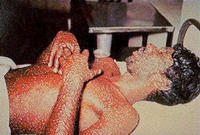-
Extreme weather exposes the toxic legacy of an industrial past
The increase in the number and intensity of extreme weather events in the United States carries with it yet another, more insidious danger: it forces to the surface toxic lead from long-shuttered smelters. Lead smelters had mostly closed down in the United States by the 1980s, but they left behind millions of tons of toxic waste. One example: In 2011, Joplin, Missouri suffered a devastating tornado which killed 158 people and flattened much of the city. Decades of lead processing in the Joplin area had created about 150 million tons of toxic wastes, with about 9 million tons still remaining after a federal Superfund cleanup. The 2011 tornado forced some of the buried lead to the surface, forcing Joplin to spend $3.5 million so far on lead clean up. The city now requires builders to test for lead, and clean up any traces, before beginning construction.
-
-
Experiments with dangerous bird flu stains pose risk of accidental release
Experiments creating dangerous flu strain that are transmissible between mammals pose too great a risk to human life from potential release, according to researchers. Although experiments on these so-called novel potential pandemic pathogens (PPPs) are conducted at high levels of biosecurity, the researchers argue that they pose a substantial risk to human life. They are calling for greater scrutiny of experiments that make virulent influenza strains transmissible, and for future studies on flu transmission to use safer and more effective alternative approaches.
-
-
Mustard plants help detect use of chemical weapons
Making nations comply with the Chemical Weapons Convention requires that scientists can accurately detect the use of chemical warfare agents. Currently they carry out tests on soil from areas where use is suspected. Many nerve agents composed of organo-phosophorous compounds, however, leach from soil over time, removing the evidence of use and making verifying the deployment of chemical weapons like sarin, soman, and VX difficult. Researchers report that white mustard plants can help by allowing detection for up to forty-five days after the chemical weapons were used.
-
-
Soil bacteria may offer insights into curbing antibiotic resistance
Drug-resistant bacteria annually sicken two million Americans and kill at least 23,000. Antibiotic-resistant disease now adds $20 billion to annual health-care costs and leads to eight million additional hospital treatment days in the United States. A driving force behind this growing public health threat is the ability of bacteria to share genes that provide antibiotic resistance. Bacteria that naturally live in the soil have a vast collection of genes to fight off antibiotics, but they are much less likely to share these genes, suggesting that most genes from soil bacteria are not poised to contribute to antibiotic resistance in infectious bacteria.
-
-
Cesium chloride blood irradiators increase dirty bomb risk
Federal officials want to halt the use of blood irradiators used by hospitals and blood centers to ensure that blood is properly treated before transfusions occur. The irradiation devices contain cesium chloride, a highly radioactive powder which terrorists could use to make a dirty bomb. A 2008 reportby the National Academy of Sciences recommended stopping the licensing of new cesium chloride radiation sources, thereby encouraging the adoption of alternative sources with a less dispersible form of radioactive cesium, including cobalt-60 or X-ray irradiators.
-
-
Converting light to sound for better weapons detection, medical imaging
A device that essentially listens for light waves could help open up the last frontier of the electromagnetic spectrum — the terahertz range. So-called T-rays, which are light waves too long for human eyes to see, could help airport security guards find chemical and other weapons. They might let doctors image body tissues with less damage to healthy areas. They could also give astronomers new tools to study planets in other solar systems. Those are just a few possible applications.
-
-
Border Collies chase away beach contamination
Gull droppings may be one source of the indicator bacterium Escherichia coli to beach water, which can lead to swim advisories and beach closings. Border Collies are effective at reducing gull congregation on recreational beaches, resulting in lower E. coli abundance in the sand.
-
-
Bill would encourage development of drugs to treat antibiotic-resistant bacteria
The U.S. Centers for Disease Control and Prevention(CDC) reported that two million Americans are infected by antibiotic-resistant pathogens every year, and the pathogens cause 23,000 deaths annually. In 1990, about twenty pharmaceutical companies had large antibiotic research and development programs, but today only three large firms and a few small companies are investing in antibiotic research. A new proposed bill, the Developing an Innovative Strategy for Antimicrobial Resistant Microorganisms Act, would encourage pharmaceutical companies to develop new drugs to treat antibiotic-resistant bacteria.
-
-
Absorbent used in kitty litter may be cause of radiation leaks in U.S. nuke dump
A wheat-based absorbent often used in kitty litter may be the likely cause of the radiation leak that led to the closure of the Waste Isolation Pilot Plant(WIPP), the U.S. only underground nuclear waste repository, according to Jim Conca, a former geochemist at Los Alamos National Laboratory(LANL). Conca noted that EnergySolutions, a Salt Lake City-based company hired to package radioactive waste at LANL into containers for shipment to the WIPP, switched from using a clay-based absorbent in the storage drums to a wheat-based mixture.
-
-
Pandemics: who should be given life-saving treatment first? Who should make the decision?
In the event of a flu pandemic, who should have priority access to life-saving ventilators, and who should make that determination? Few disaster preparedness plans have taken community values regarding allocation into account, but a new study is aiming to change that through public engagement with Maryland residents. “In the event of a healthcare crisis, understanding the community perspective and having citizen buy-in will be critical to avoid compounding the initial disaster with further social upheaval,” says the principal investigator.
-
-
Better understanding of the 1918 Flu Pandemic aids in better infectious disease response today
The 1918 Flu Pandemic infected over 500 million people, killing at least fifty million. Now, researchers have analyzed the pandemic in two remote regions of North America, finding that despite their geographical divide, both regions had environmental, nutritional, and economic factors that influenced morbidity during the pandemic. Findings from the research could help improve current health policies.
-
-
New biodefense centers offer modernized approach, face criticism
A new facility at Texas A&M University is one of three new biodefense centers created by the U.S. Department of Health and Human Services (HHS) to revolutionize the way fatal viruses are countered in the event of an emergency. The $286-million lab features mobile clean rooms that can be detached and moved to form different production or testing systems as the need arises. Not everyone agrees that the design and capabilities of the new center would offer the best response to biothreats.
-
-
Debate intensifies over whether or not to destroy last stockpile of smallpox

The world’s health ministers are scheduled to meet later this month to discuss the fate of the last known stockpiles of smallpox, held under tight security in two labs— one in the United States and the other in Russia. Smallpox has been eradicated for more than three decades, but some U.S. health officials say the remaining stockpiles should be kept for further studies. The smallpox virus is being used to develop drugs and safer vaccines in case the virus returns through terrorism or a lab accident. Member nations of the World Health Organization (WHO) once agreed that the last virus strains known to officials would eventually be destroyed, but a set date was never agreed upon.
-
-
California bill banning use of antibiotics in livestock withdrawn

The Centers for Disease Control and Preventionreports that 23,000 people die every year from infections that cannot be cured, often due to overuse of antibiotics which creates drug resistant bugs. Last Wednesday, California Assemblyman Kevin Mullin (D-San Mateo) withdrew proposed legislation which would ban the sale of meat and poultry fed on nontherapeutic antibiotics. He lacked sufficient support from fellow legislators.
-
-
New technology to detect previously undetectable fecal contamination in water
Technology capable of sampling water systems to find indicators of fecal matter contamination that are thousandths and even millionths of times smaller than those found by conventional methods is being developed by researchers. The researchers have developed an ultrasensitive detection method that can detect molecules associated with human and animal fecal matter in water systems. These extremely small indicators, he explains, have been traditionally difficult to detect but can signal greater levels of contamination, which can lead to illness and even death.
-
More headlines
The long view
We Ran the C.D.C.: Kennedy Is Endangering Every American’s Health
Nine former leaders of the Centers for Disease Control and Prevention (CDC), who served as directors or acting directors under Republican and Democratic administrations, serving under presidents from Jimmy Carter to Donald Trrump, argue that HHS Secretary Roert F. Kennedy Jr. poses a clear and present danger to the health of Americans. He has placed anti-vaxxers and conspiracy theorists at top HHS positions, and he appears to be guided by a hostility to science and a belief in bizarre, unscientific approaches to public health.
